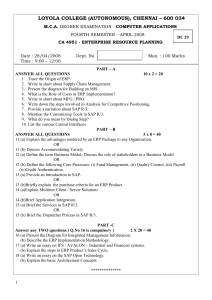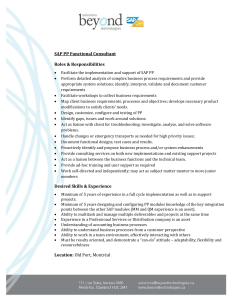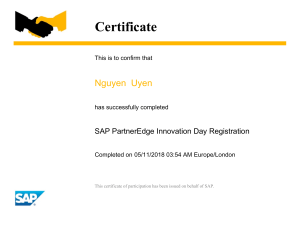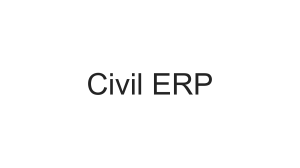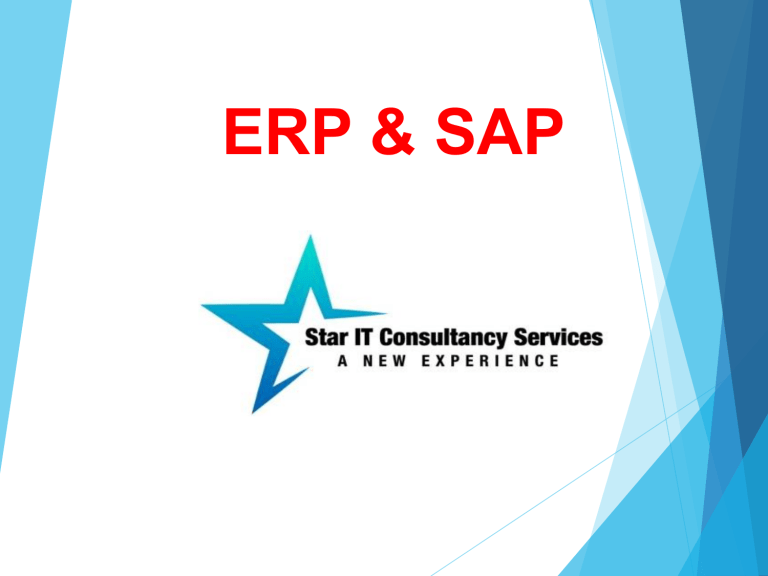
ERP & SAP ERP Systems ERP systems increase productivity. Because an ERP system integrates data and processes across multiple departments and locations, it allows a company to move product faster, process orders quicker, invoice customers more rapidly and reconcile shipments sooner. 2 Why do companies need ERP systems? Enterprise resource planning (ERP) systems are used by organizations looking to manage their business functions within a centralized and integrated system. ERP is commonly used by companies working within the supply chain to help keep track of all the moving parts of manufacturing and distribution. 3 What is scope of ERP? ERP has a huge scope & helps in fulfilment of various business needs: Production Department. It includes Engineering, Bills of Material, Scheduling, Capacity, Workflow Management, Quality Control, Cost Management, Manufacturing Process, Manufacturing Projects, Manufacturing Flow. Supply Chain Management. 4 How does ERP system work? In general, ERP uses a centralized database for various business processes to reduce manual labour and to simplify existing business workflows. ERP systems typically contain dashboards where users can look at real-time data collected from all across the business to measure productivity and profitability. 5 Advantages of ERP 1. Focused IT Costs Although ERP is often a large investment, it can unify your IT costs and improve efficiency. Instead of spending resources on multiple systems that all need dedicated staff, infrastructure, support teams and licenses, you can focus all these costs into one ERP. 2. Total Visibility This benefit of ERP is one of the biggest selling points for the software. ERP allows total access to every important process in your business by making data from every department easily accessible to you and your senior 6 management. 3. Improved Reporting and Planning Along with improved visibility, better insight is a major advantage of ERP. Implementing an ERP suite across departments means your organization has a single, unified reporting system for every process. By having a single source of truth, an ERP system can readily generate useful reports and analytics at any time. This software gives you the ability to analyse and compare functions across departments, without the hassle of multiple spreadsheets and emails. 7 4. Complete Customization One of the biggest advantages of enterprise resource planning software in the present day is its modular makeup. Most ERP vendors offer several applications that can be implemented together according to business needs. Barring a few exceptions, each application is designed to be able to stand alone or integrate with the larger suite. This way, your company can pick and choose which components work best and can leave out what you don’t need. 8 5. Improved Efficiency Along with reduced IT and training costs, an ERP can reduce the time and effort required by your workforce to carry out their daily activities. Properly implemented, an ERP can greatly reduce or eliminate repetitive manual processes, thus freeing up team members to focus on revenue-affecting tasks. 6. Customer Service Your company’s clients also receive ERP system benefits, even if they don’t know it. Because client information is centralized and streamlined, your sales team will be able to focus on building and maintaining customer relationships instead of maintaining spreadsheets. 9 7. Data Security and Quality One of the biggest advantages of an ERP system is data security. After all, at the heart of the ERP concept is data. Sharing data across functional silos such as customer service, sales, marketing and business development enhances collaboration throughout a company. The other side to widespread data access is controlling who can see and edit the information. ERP solutions have intrinsic controls to ensure the security of your data. 10 8. Improved Collaboration and Workflows Collaboration is an essential part of a thriving business. But more often than not, companies find their teams working in silos simply because collaboration requires more time and effort. But ERP makes collaboration a piece of cake. An ERP platform streamlines the process of collaborating with others by providing employees with access to the data they need when they need it. 9. Standardized Business Processes Most ERP systems are developed according to industry best practices. These tried-and-true processes bring major benefits to the table for businesses of all sizes. It also allows businesses to standardize their own processes and systems, which further enhances productivity and efficiency. 11 10. Facilitated Regulatory Compliance One of the most difficult ongoing tasks for businesses is meeting compliance requirements. Maintaining perfect accuracy within your financial records isn’t exactly easy, but needs to be done nevertheless. ERPs aid in regulatory compliance by virtue of secure and validated data, combined with built-in reports. These reports can also be automated to reduce the cost of continual audits. 11. Improved Supply Chain Management For companies that deal with the moving of physical inventory and production, an ERP system bolsters supply chain management in a variety of ways. This improvement results in shortened lead times, more on-time deliveries and many other benefits that enhance the overall operation and success of your business. Through a well-designed ERP platform, your supply chain can become better and more responsive via improved demand forecasting, inventory management, procurement and 12 more. 12. Superior Scalability To ensure the ongoing success of your business, you have to keep an eye on the future. All too often, businesses fail to plan properly and experience serious growing pains that pose serious roadblocks to whatever progress they’re enjoying. Having a system in place that can elegantly and efficiently accommodate your company’s growth is of the utmost importance, and the right ERP system makes it easy. 13 Should You Invest in ERP or Not? When making a decision about which platform is right for your business, it’s important to consider the pros and cons of ERP software. But you shouldn’t let the potential downfalls scare you away from the tools that could take your business to the next level. Experts like Star It Consultancy Services recommend making an honest assessment of your organization’s needs and problem areas and then seeking out an ERP system that will give your business the most potential to improve. The potential for totally streamlined business functions and boosts in productivity over the long-term makes the benefits of implementing ERP systems a worthwhile investment of time and resources. SAP SAP: SAP stands for Systems, Applications, Products in data processing. SAP is the third largest enterprise software company in the world. 15 About SAP ERP SAP Has no. of products but in ERP segment SAP has total three popular ERP: 1.) SAP S4 HANA(On Premises and On Cloud) 2.) SAP Business One SQL & HANA(On Premises and On Cloud) 3.) SAP Business By design( On Cloud) 16 SAP On HANA SAP S/4 HANA and SAP Business One on HANA ERP is the next-generation go-to Business Suite tool for SAP. The on-premise version gives you high degrees of control and Flexibility, SAP HANA brings together transactions and analytics into a single in-memory platform for smarter business innovations, faster business processes, and simpler business interactions. SAP S/4HANA has been created to enable your business to transform. Processes run quicker, real-time analytics allow for more accurate decision-making. 17 Versions There are two current versions within S/4HANA with a different scope: SAP S/4HANA Finance is based on the core ECC solution. The Finance modules, tables and processes have been simplified whilst the remaining areas have been untouched. Additional new functionality has been released within the Finance space. SAP S/4HANA Enterprise Management has a wider scope, with Materials Management and Operations simplified as well as Finance. A number of new functionalities have been released and many traditional modules have been removed. With the aim to ‘run simple’, SAP has a paradigm of the ‘principle of one’ where there will be only one module or process for a particular area, rather than the few that were traditionally available within ECC. Industry-specific functionality will be added to S/4HANA over time as it evolves. 18 Why SAP S/4HANA? SAP S/4HANA has been created to enable your business to transform. Processes run quicker, real-time analytics allow for more accurate decision-making, and there is an improved user experience for your teams. Business transformation SAP S/4HANA is designed to provide business transformation for your organisation. This transformation may be subtle or very dramatic. Each organisation will approach S/4HANA from a different baseline, with different objectives and therefore there is not a single set of motives to move to S/4HANA. Simplified data model One of the core concepts of S/4HANA is the change in which data is held within it. The new data models will significantly reduce the size of the database which in turn will lead to performance benefits and hardware cost reductions. The new data model will allow processes to be performed in a less complex manner and reporting can be simplified as all of the data is now in a reduced number of tables. 19 SAP S4 HANA Modules Plant Maintenance (PM) Product Life Cycle Management (PLM) Human Capital Management (HCM) Production Planning (PP) Project Systems (PS) Finance ( FI) Controlling (CO) Sales and Distribution (SD) Investment Management (IM) Strategic Enterprise Management (SEM) Customer Relationship Management (CRM) Logistics Information Systems (LIS) Supply Chain Management (SCM) Customer Service (CS) Materials Management (MM) Supplier Relationship Management (SRM) Enterprise Performance Management (EPM) Treasury NetWeaver Environment, Health and Safety (EHS) and many more…!! 20 Advantages of Using SAP HANA Following are the advantages of using SAP HANA as underlying database. Real-time data analysis Elimination of unnecessary complexity of hardware No latency in database due to nightly ETL jobs In-memory database Column store supports calculations on the run Parallel processing Data compression 21 SAP Industry Solutions(Some Example) SAP for Aerospace & Defence SAP for Media SAP for Automotive SAP for Mill Products SAP for Banking SAP for Mining SAP for Chemicals SAP for Oil & Gas SAP for Consumer Products SAP for Pharmaceuticals SAP for Engineering, Construction & Operations 22 SAP Industry Solutions(Some Example) SAP for Professional Services SAP for Healthcare SAP for Public Sector SAP for High Tech SAP for Retail SAP for Higher Education & Research SAP for Service Providers SAP for Industrial Machinery & Components SAP for Telecommunications SAP for Insurance SAP for Utilities and many more industries…!! 23 SAP Business One on SQL/HANA SAP Business One are arranged into 14 functional modules, covering the typical functions in a business organization. The most widely used modules are Financials, Sales Opportunities, Sales – A/R, Purchasing A/P, Business Partners, Banking and Inventory. Modules: Administration, where setup of the various core settings in the application are done. Financials, where definition of Chart of Account are set up and the core Journal Entries can be created. Opportunities/CRM, where Lead generation are used to keep track of potential Sales and Purchases. Sales - A/R(Account Receivable), where the sales flow (Quotation > Order > Delivery > Invoice) are managed. Purchasing - A/P(Account payable), where the purchase flow (Quotation > Order > Delivery > Invoice) are managed. Business Partners, where master data of Leads, Customer and24Supplier are maintained. Banking, where payment of Incoming (sales) and Outgoing (purchase) payments are created. Inventory, where master data of goods to be sold/purchased are maintained and their quantity/value in warehouses are tracked. Resources, where master data of resources (machines and people) to be used in production are defined (capacity and planning). Production, where Bill of Materials master data are maintained and Production orders are created. Project Management, where you define projects (what you do when). Material Requirements planning (MRP), where forecasts of needed items in sales/production are defined in order to make purchase order recommendations. Service, where management of service contracts are maintained and service calls are created. Human Resources, where employee master data (Names, contract information, roles, etc.) are maintained. Each module handled specific business tasks on its own, but is linked to the other modules where applicable. For instance, an invoice from the billing transaction of Sales & Distribution would pass through to accounting, where it25will appear in accounts receivable and cost of goods sold. SAP Business By Design SAP Business ByDesign (ByD) is a cloud enterprise resource planning software (Cloud ERP) The software is designed to provide business processes across application areas from financials to human resources with embedded business analytics, mobility, e-learning, and support. SAP Business ByDesign is built on the principles of a service oriented architecture (SOA). Integration between business capabilities is accomplished via messages. The underlying technology stack is a multi-tenancy enabled SAP NetWeaver stack, leveraging SAP's in-memory HANA database. 26 The main application areas and core business scenarios are: •Financial management(FIN): Cash and Liquidity Management, Financial Closing, Fixed Asset Management •Customer relationship management(CRM): Marketing to Opportunity, Field Service and Repair, Order to cash (projects, standard service, materials) •Project management and professional service automation(PSA / PRO): Project Management •Supplier relationship management and procurement(SRM): Procure to pay (stock and non stock) •Supply chain management(SCM): Demand Planning, Strategic sourcing, Make to stock, Physical Inventory Management, •Human resources management(HCM): Expense Reimbursement, Resource Management, Time and Labor Management •Business analytics(BA or BI) •Executive support and compliance management27 SAP Implementation Approach & Methodology in Five(5) Steps. 28 Thank you Dhirenjeet Saha Founder & Director Star IT Consultancy Services www.staritcs.com Cell: +91 96571 56561 & +91 96233 47833 Mail: dhirenjeet.saha@staritcs.com 29
